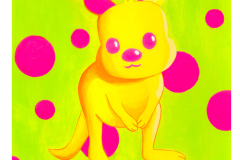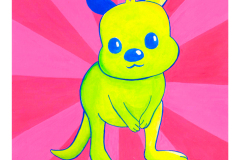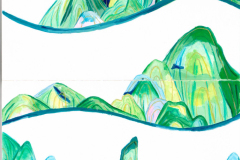Introduction
Small canvas art offers a unique way to personalize and brighten compact living spaces. These artworks fit well in limited areas without crowding, allowing you to display your style. Gouache painting, known for its rich and opaque qualities, works wonderfully on small canvases. It brings a fresh and delicate touch that stands out in tight environments. Exploring the use of small-scale gouache art can transform your space into a vibrant and inviting area.
Your compact space does not need big changes to show personality. Small canvas art pieces painted with gouache provide an ideal means of decoration. These works pack a punch in visual appeal despite their size. Choosing the right canvases and designs can enhance your room’s ambiance. Thoughtful placement of gouache artworks on small canvas creates focal points that draw attention and invite admiration.
Understanding Small Canvas Art
Small canvas art refers to paintings created on canvases that are generally under 16 by 20 inches. These compact pieces fit easily into tight or limited spaces. Their size makes them ideal for adding visual interest without overwhelming the room.
People use small canvas art to decorate corners, shelves, or walls where large pieces wouldn’t fit. You might see them in apartments, offices, or cozy nooks. They offer flexibility in how you display your art.
Arranging several small canvases in grids or clusters creates a curated look that fills a wall with personality. This arrangement suits compact spaces well because you can keep the artwork proportionate to your room size. Small canvases invite you to experiment with layout and style without commitment to a single large piece.
Sizes and Styles of Small Canvas
Common sizes for small canvases include 5×7, 8×10, and 11×14 inches. These dimensions balance detail with portability, letting artists work on focused subjects or abstract designs.
Styles vary widely, from minimalist sketches to bold abstracts or fine detailed portraits. Artists often adjust their technique to fit the small surface, using both delicate strokes and vibrant colors.
You can choose framed canvases or opt for gallery wraps, where the image continues around the edges. Gallery wraps give a modern look and often need no additional framing, saving wall space and simplifying installation.
Benefits of Small Canvases for Decoration
Small canvases are easy to move, making them great for renters or anyone who likes changing their décor often. You can hang them almost anywhere and rearrange without hassle.
Creating clusters with multiple small canvases allows you to tailor art to your available space. You can fill a blank wall with a mix of images that reflect your personality without crowding the room.
For compact homes, small canvases avoid cluttering surfaces or overwhelming walls. Their size encourages you to focus on quality and detail. Renting? Small canvases leave minimal holes and damage, so you stay within lease agreements while brightening your space.
Why Choose Gouache for Small Canvas Art
Characteristics of Gouache Paint
Gouache paint stands out from watercolor and acrylic because of its solid, flat coverage. You can re-wet it even after it dries, which allows for easy corrections and blending. Unlike watercolor, which is mostly transparent, gouache blocks underlying layers completely. This opacity means your small canvas art can display sharp, clear details without the colors merging or fading. The paint also dries to a smooth matte finish, reducing glare and making the colors visible from different lighting angles. These features make gouache ideal if you want precise, bright artwork in a small space.
Advantages of Gouache on Small Canvases
Gouache paints dry quickly, which benefits small canvases where you often work in layers. You can add fine details without waiting long, speeding up your process. The colors stay vibrant and don’t darken as much when dry, which keeps your compact artwork lively and eye-catching. Since walls in compact spaces benefit from bold yet subtle decorations, gouache’s versatility lets your small painting pop without overwhelming the area. Have you noticed how certain colors and shapes can transform a tiny wall? Gouache helps bring those ideas to life with ease and precision.
Planning Your Gouache Small Canvas Art Project
Starting a gouache project on a small canvas requires clear planning. Begin by deciding what message or mood you want your piece to convey. Think about how the artwork will fit the small space you have. Will it add calmness, energy, or curiosity?
Choosing a color scheme helps keep the final work focused. Limit your palette to a few colors that complement your setting. Are you drawn to warm tones that brighten a room or cool shades that bring peace? Test color mixes on paper before moving to canvas.
Gather materials suited for detail and control. Small canvases call for fine brushes with firm bristles. Pick gouache tubes that offer opacity and blend well. Prepare your workspace with good lighting and organize your tools within easy reach. A clutter-free area helps you focus on delicate strokes.
Selecting Themes and Inspirations
Your theme sets the tone for small gouache paintings. Popular choices include nature scenes like leaves or flowers, which bring softness to small spaces. Abstract shapes invite interpretation and keep things visually interesting without overwhelming a room.
Minimalist designs work well. Simple lines or geometric forms create balance and cleanliness. Think about patterns you enjoy or everyday objects seen in a new way. What small detail from your surroundings could become a subject? Personal themes often make your art more meaningful.
Sketch several thumbnail ideas. This helps decide what fits best on a small canvas while keeping the composition balanced. Which theme excites you most to paint?
Preparing Materials and Workspace
Prepare small canvases, usually between 4×4 and 8×8 inches. These sizes suit tight spaces and allow for detailed work. Use canvas boards or stretched canvases with a fine texture for better paint grip.
You need quality gouache paints in colors that suit your palette. Brushes with fine tips, round shapes, and various sizes let you handle details and backgrounds effectively. Have water containers, palettes, and paper towels nearby.
Set up your workspace with steady light, ideally natural, or a daylight lamp. Keep surfaces clean and flat. Tape your canvas onto a board if it helps keep it stable while you paint. Organize your materials to avoid interruptions.
Working in a quiet space helps maintain focus when painting delicate details. Are you ready to set up a space that supports careful, controlled strokes on your small canvas?
Techniques for Painting Gouache on Small Canvases
Working with gouache on small canvases requires fine control and careful technique. Small surfaces leave little room for errors but offer a chance to focus on precise details that make your artwork stand out.
Building your painting in layers allows you to control color depth and texture. Start with thin washes, then apply thicker, more opaque layers. Each layer should dry before adding the next to avoid muddy colors. Watch how the matte quality of gouache responds to layering, as it can create smooth or textured effects depending on your brushwork.
Blending colors on a tiny canvas takes patience. Use a damp brush to soften edges while paint is still wet. Test blending on a scrap piece to avoid overworking the paint, which can lift underlying layers.
Small canvases demand focus on minute details. Using fine brushes with firm tips helps you add sharp lines or delicate patterns that draw viewers’ eyes. Keep your wrist steady and practice controlled strokes before working on the final piece.
Layering and Opacity Control
Gouache excels at layering due to its opacity. Apply thin first layers to establish basic shapes and tones on your canvas. Let each layer dry completely before painting over it to keep colors vibrant and clean.
Experiment with mixing water and paint to control transparency. A little water thins the paint for translucent effects, while thicker applications keep colors solid and bright. On small canvases, this control helps you create texture without overwhelming the limited space.
Gradually building layers allows light to reflect through upper colors, adding richness. For example, paint a soft blue sky with a light base and snap brighter details on top. This technique can make compact scenes feel more dimensional.
Do you notice how your paint changes with each layer? Pay attention and adjust your brush pressure and paint thickness to find the perfect balance for your piece.
Adding Fine Details and Highlighting
Using small, precise brushes is key for details on a small canvas. Look for round brushes size 0 to 2 that hold a fine point. These help you draw sharp lines, dots, or tiny shapes that add interest and life to your work.
Plan where to place highlights before starting. Highlights on edges or focal points can create contrast and dimension. Use diluted white gouache or lighter shades sparingly for highlights that brighten without overpowering.
Work slowly and lift your brush lightly to avoid smudging surrounding paint. You might practice steady hand exercises to build confidence for fine strokes.
How do tiny highlights change the way you see the painting? Small changes often spark the biggest visual impact in limited spaces.
Arranging Your Small Canvas Gouache Art in Compact Spaces
How can you make small gouache canvases stand out in a limited space? Grouping several pieces together creates a focal point without overwhelming the room. Arranging your canvases in a thoughtful way brings balance and energy to bare walls. Try placing pieces at eye level to invite easy viewing and conversation.
Consider the surrounding furniture and flow of the room. Avoid clutter by spacing canvases evenly or aligning them with shelves and fixtures. Mix vertical and horizontal orientations for variety, keeping each piece close enough to feel connected. Think about which wall or corner can best showcase your collection without crowding other décor.
Lighting also affects visibility and mood. Position your canvases near natural light sources or use adjustable lamps to highlight textures and colors. Reflect on your wall colors, too. Light tones can brighten the artwork, while darker backgrounds can make brighter gouache details pop. Where could your small canvases bring the most life to your space?
Creating Clusters and Gallery Walls
Grouping small canvases into clusters or mini-gallery walls adds visual interest without using much room. Select pieces that share a color theme or subject to create unity. Vary canvas sizes within the group but keep consistent spacing to look intentional, not chaotic.
Use painter’s tape or paper templates before hanging to plan your arrangement. Try shapes like rectangles or circles for the cluster to define its boundary. Mixing framed and unframed canvases can add texture, but keep consistent frame styles or colors when possible.
If you have a blank wall near your seating area, try a small gallery there. This can create a mini-exhibition focused on your favorite pieces. Ask yourself: how can grouping increase the artwork’s presence without taking over the room?
Optimizing Placement for Maximum Impact
When placing small canvases, think about where people naturally stop or look. Near couches, desks, or entryways usually works well. Place art at eye level or just above furniture to tie the space together.
Wall color affects how colors read. Lighter walls can make subtle gouache tones more visible, while darker walls create contrast for brighter colors. Make sure light sources don’t cast distracting shadows or glare on your canvases.
Arrange your small canvases so they complement, not compete with, furniture and décor. Leave enough space around each piece to let it breathe. Would shifting one piece slightly enhance its effect in your room? Experiment until your gouache art feels like it belongs.
Maintaining and Caring for Gouache Small Canvas Art
Protecting Gouache Paintings
Your gouache paintings on small canvases require careful protection because gouache is sensitive to moisture and sunlight. Exposure to water can cause the paint to soften or run. Avoid hanging your artwork in areas with high humidity, such as bathrooms or kitchens.
Sunlight can fade the vibrant colors of gouache over time. Place your canvases where they receive indirect light or use UV-protective glass if framing them. Physical contact can damage gouache’s delicate surface easily, so avoid touching the painted areas directly.
Consider framing your small canvases with spacers to prevent the glass from touching the paint. This adds a layer of defense against dust and accidents. How often do you check the environment around your artwork? Small changes in temperature and light can create big effects over months.
Cleaning and Storage Tips
When cleaning small gouache canvases, dust gently with a soft, dry brush or a microfiber cloth. Avoid using water or cleaners, which can dissolve the paint. If your artwork is framed behind glass, use a glass cleaner only on the outer surface of the frame.
If you need to store your gouache canvases, place them upright in a dry, cool place away from direct heat or sunlight. Wrap them in acid-free tissue paper to prevent scratches and protect the paint surface.
Stacking canvases directly on top of each other can cause damage, so use rigid dividers to keep them separate. Have you prepared a specific spot just for your art storage? Proper organization helps your small canvases stay safe and ready to brighten your space again.
Inspiring Ideas for Gouache Small Canvas Art Themes
Choosing the right subject for gouache on small canvases can transform compact spaces into lively spots. Small canvas art works well with themes that deliver clear, focused visuals without overcrowding. You might consider serene nature scenes, eye-catching shapes, or minimalist compositions that suit your room’s style.
Think about how each painting interacts with the space around it. Could a tiny canvas with soft floral details create a calm corner? Might sharp geometric forms add a fresh, structured feel to your shelf? Selecting themes that balance complexity with simplicity helps avoid overwhelming tight areas.
How do your daily surroundings influence what you want on your walls? Drawing inspiration from what you see outside your windows or your favorite local spots could guide your theme choice. Experimenting within these ideas can keep your collection interesting and personal, matching any change in mood or decor.
Nature and Botanical Themes
Flowers, leaves, and small natural landscapes fit perfectly on small canvases. You can paint delicate petals or a few scattered leaves to evoke calm without crowding your space. These themes bring a peaceful, fresh look that works well in bedrooms or reading nooks.
Try painting tiny succulents in pastel tones or a close-up of a single flower’s texture. Such focused details grab attention gently instead of dominating the room. What small plant or natural scene appeals to you daily? Capturing it could create a relaxing focal point.
This approach often invites a peaceful mood without needing a large picture. You keep your walls visually interesting while maintaining that feel of openness important in compact spaces.
Abstract and Geometric Designs
Shapes, lines, and blocks of color make strong statements on small canvases. Abstract art lets you play with modern themes that fit well in tight spots without demanding much surface area.
Try color blocking with contrasting shades or repeat simple patterns like triangles or circles. These designs offer dynamic visuals that keep your space feeling contemporary and balanced. How can you arrange shapes to match your furniture or wall color?
Playing with symmetry, balance, and color intensity can create a bold or subtle effect depending on your mood. Abstract art on small canvases encourages you to explore your style without committing to large pieces that could overwhelm your room.
Expanding Your Collection and Style Over Time
Building your collection of small gouache canvases works best when you do it step by step. Buy or create a few pieces at first, then add more as you learn what styles and themes speak to you. This gradual growth helps you see which artworks fit well in your space and which don’t.
As you become familiar with different subjects and colors, try mixing styles. For example, pair abstract designs next to simple botanical paintings. How could these choices change the mood of your room?
Allow your collection to reflect changes in your taste or in the seasons. Swapping out a few canvases now and then keeps your space fresh without taking up more room. This way, your living area grows richer in personality over time, with art that feels uniquely yours.
Trying New Techniques and Subjects
Experimenting with new brush techniques can reveal fresh ways to express yourself. Try dry brushing for texture or wet-on-wet for smooth blends. How does each change the feel of your small canvas?
Start with simple shapes or patterns, then move to more complex subjects like cityscapes or animals. Changing themes keeps the process exciting and helps you discover your strengths.
Record your progress by keeping some canvases from different stages. Seeing how your technique improves can motivate you to push further. What new style could you try in your next piece?
Integrating Art with Home Decor
Match your small gouache paintings with furniture shapes or fabric patterns for a balanced look. If you have a soft couch, try canvases with fluid lines or calming colors. Sharp-edged furniture can pair well with geometric pieces.
Use colors in your canvases to echo or contrast with curtains, rugs, or pillows. A bright painting can add energy next to neutral textiles, while muted art tones can calm a busy patterned space.
Position your canvases where natural light highlights their details. Group artworks in small clusters near shelves or above a table to create a focal point. How can you arrange your art to highlight both the painting and the room?
Conclusions
Small canvas art painted with gouache brings elegance to compact living spaces. These works allow you to decorate with color and style without overwhelming your area. The durability and vibrant finish of gouache paint make it perfect for small artworks shown in tight quarters. You have many options for choosing themes and patterns that fit your taste while complementing your room’s design. Displaying gouache paintings thoughtfully enriches your home atmosphere.
Using gouache on small canvases is a practical solution for anyone wanting to decorate smaller rooms effectively. This approach suits renters, minimalists, and people with limited wall space. You can create a series or stand-alone pieces that brighten and warm your surroundings. Small art lets you experiment with contrasts and details that big canvases cannot offer. Your compact space benefits greatly from these simple yet impressive artistic touches.
























